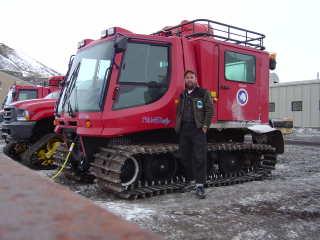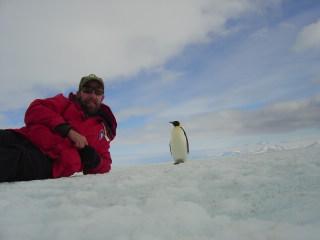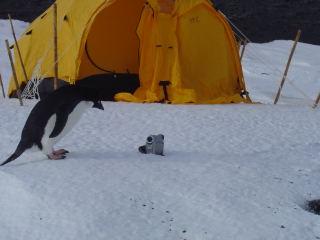
|
|
25 November, 2003
Life down under.
Where our parcticular research is taking us, we do not expect to see any evidence of life except that of past life. So with great anticipation, we headed out towards Cape Royds, to do our shake down trip where we will evaluate our camping gear and practice rescue techniques. At Cape Royds, there is an Adelie penguin rookery where we might satiate our thirst for some Antarctic wildlife. Well on this excursion our thirst was not only satiated but we almost drowned in the wonders of Antarctic life. To be honest, we did not see a wide variety, but we did see numbers that instilled in us an admiration of the heartiness of these species as well as an appreciation of ultimate toll that this continent exacts on so many life forms.
We left McMurdo around noon Sunday and traveled out over McMurdo Ice shelf. The ice shelf still is a couple meters thick at this time of year, but the water underneath is several hundred meters deep and effected by tides. This means that from the volcanic land of McMurdo, across the transition zone to deep water is only a hundred yards or so which makes the transition zone quite dangerous. Cracks open daily and McMurdo's loaders and graders are constantly at work filling in cracks and smoothing out pressure ridges. One has to pay constant attention to the flagged routes keeping a wary eye out for the dreaded black flag, a place where you dare not travel. Keep your vehicle between the red and green flags in high traffic areas (Red Right Returning, sailors!) and along the green flags along the less trafficked "roads". Seeing these flagged lines across the ice reminded me of the stories Plattsburgh natives told me of the Cedar Highway that led from Plattsburgh, New York to Burlington, Vermont when lake Champlain would freeze over, something that is happening with less frequency as our environment warms.
So off we go in our Piston Bully, which is a machine similar to a snow groomer without the blades and rollers. Peter Braddock, our mountaineer drives since he knows how to read the ice for hidden dangers that may not be marked. Top speed for these machines is about 15 miles per hour so the 22-mile trip will take a couple of hours without stops. But every so often the view would be so breathtaking, that we would ask Peter to stop so we could take some really good photos without the jarring of the Piston Bully jostling out cameras. At one stop, a group of penguins got curious and ventured over to us in their side-to-side waddle. I think they were as curious of us as we were of them. Turning their head from side to side, they stopped a short distance off "talking" to each other and looking at us, first one way then another. To break the stalemate, we (the humans) all lay down on our stomachs with cameras in hand and soon the penguins came closer. Then, with a couple of trumpeting sounds they left as awkwardly as they arrived, waddling from side to side, seeming to mutter as they retreated. "What are those weird bipeds doing out on the ice? Don't they know it's dangerous?"
We continued on past Cape Evans and Hut Point where Scott's party lived before setting off for the Pole, towards Cape Royds and Shackleton's camp. Here we tucked into a sheltered bit of land where we set up camp. The team set a couple of Scott tents, Peter and I set up mountain tents and we had a secure camp in short order. Since we had a bit of time before dinner, we thought we would walk over to the rookery and see how the penguins were doing. As we climbed through the scree and boulders of basalt and volcanic scoria, Peter explained that the colony had taken a big hit a few years back when the sea ice got trapped near the shore. The female penguins laid their eggs and then went off to feed leaving the males to incubate the eggs and await the females' return. Well, the distance to open water was so great that many of the females did not make it to the open water to feed and many of the waiting males who were living off their stored fat while incubating the eggs, soon became too weak to survive themselves. Thus this seemingly small change in the sea ice dealt a devastating blow to the colony. Peter went on to tell us that they were just starting to make a come back so it was ever more important to be careful not to stress the colony in any way and we should keep a good distance.
We arrived a Shackleton's hut and found someone had obtained the key so we were able to go in for a look around. I won't spend time here on what we found but having read several books on his expeditions, and now seeing the artifacts first hand, gave the written word greater meaning.
Outside, the racket from the colony was not raucous, but it sounded more like the "wave" at a football game. It would start on one side and travel through the colony to the other and stop, a while later, it would begin again. We climbed a hill overlooking the colony and we could see open water not far off shore to the North. Some penguins were hanging around the water but none ventured in. Others traveled back and forth moving around on the ice in what appeared as an unsteady walk but I did not see one slip and tumble almost like the comic drunk in a movie.
Our stomachs told us it must be dinnertime even thought the sun gave no indication of it, so we headed back to camp to boil water for our "dehi" or freeze dried dinner of beef stroganoff! As we were heating the water, I noticed off down the ice from our camp, 5 dark shapes moving somewhat randomly towards us. As they got larger I recognized the gait, it was a group of penguins. They toddled towards us, then pause as if in conversation then resume their advance. Soon they were upon us and we set about scrambling for our cameras! I do not know who was more comical in their actions, them or us! This group must have been the "Neighborhood Hospitality" group. They toddled around, giving out a squawk from time to time looking at us with alternating eyes. I guess they did not think much of us, for as quickly as they came, they left. You could almost hear them mutter as they left "There goes the neighborhood!"
Our gear worked well and we were all warm in our Arctic Storm sleeping bags. In the morning, after a quick breakfast of oatmeal and tea, we broke camp for our return ride in the Piston Bully back to McMurdo. I got to drive the return since Peter was confident of the ice's integrity but we still stopped on some of the larger cracks to double check, the rule of thumb is to drill any crack greater than 1/3 of the track length. We stopped at Cape Evans to see Scott's hut but it was locked so we just walked around a bit. There, a female seal and her pup were basking in the sun waving their flippers almost in a greeting. A couple of man-made holes in the ice must have lured them out from the sea; I hope they don't freeze up before they need to return. The seals seemed totally unperturbed with our presence, I wondered if it would have been the same years ago when they were heavily hunted.
Switching drivers, Nate, continued our journey back to McMurdo, this was the day of the solar eclipse and even though it was only 75% here, we were still hoping to get a glimpse of it. The clouds were pretty thick but they did thin enough for us to see it at its maximum. Folks here who had better conditions and were on the other side of the continent, got to see it in totality and uploaded the pictures they took to the "I" drive on the McMurdo intranet so we could all share in this rare treat of nature. Well I could go on and on but I am sure you must be bored now so I will close this entry and get some rest. Tomorrow, final preparations!
Take care,
Andy

A Piston Bully, the Mercedes of Antarctic travel. Not fast but it can turn right around on its self!

G298M stands in front of Mt. Erebus. From left to right: Dr. William Hammer, Peter Braddock, Nate Smith, Kevin Kruger, Dr. Phillip Currie, Andy Sajor

A couple of curious birds.

Take me to your leader!

There goes the neighborhood!
Contact the TEA in the field at
.
If you cannot connect through your browser, copy the
TEA's e-mail address in the "To:" line of
your favorite e-mail package.
|
